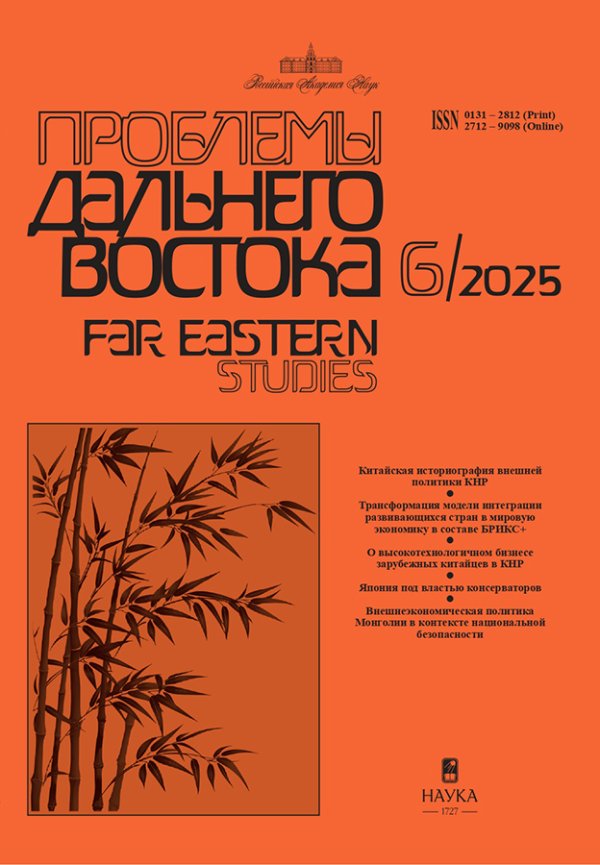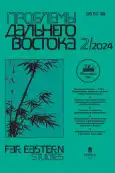Information Technology and Chinese Characters
- Authors: Zavyalova O.I.1
-
Affiliations:
- Institute of China and Contemporary Asia of the Russian Academy of Sciences
- Issue: No 2 (2024)
- Pages: 157-167
- Section: Culture
- URL: https://journals.rcsi.science/0131-2812/article/view/259073
- DOI: https://doi.org/10.31857/S0131281224020125
- ID: 259073
Full Text
Abstract
Already in ancient China, philologists started compiling the lists that comprised thousands of characters. The task of creating such lists for various purposes is still relevant in the epoch of information technology and high literacy rates. New words are regularly appearing in the Chinese language, both neologisms and loanwords. The authorities and the Chinese society as a whole show a growing interest in traditional culture and the classical texts of various periods. In modern publications, there are more and more elements from Ancient Chinese and its successor, the Classical written language Wenyan. Due to all these processes, the number of different characters in the present day texts is constantly increasing. New graphs are not created, however, they use those characters, which usually represented in the past or still represent this or that monosyllabic word or a morpheme in disyllabic and polysyllabic words. On the one hand, any characters can be entered on computers with the help of the official Romanized Hanyu Pinyin alphabet or even with the help of the voice input. Modern Chinese, especially the younger generation, not very often write texts by hand. As a result, there is a concern in the Chinese society that the same information technology, and in particular artificial intelligence, will eventually decrease the literacy level even of the educated generation. On the other hand, in the wave of the revival of traditional culture, Chinese intellectuals proposed to return those original variants of characters that were abolished in the People’s Republic of China in the 1950s and the 1960s.
About the authors
Olga I. Zavyalova
Institute of China and Contemporary Asia of the Russian Academy of Sciences
Author for correspondence.
Email: olgazavyalova@yahoo.com
ORCID iD: 0000-0003-3355-4598
Dr.Sc. (Linguistics), Leading Researcher
Moscow, Russian FederationReferences
- Завьялова О.И. Большой мир китайского языка. М.: Восточная книга, 2014. 320 с.
- Завьялова О.И. Иероглифы для диалектов: от средневекового байхуа до интернета // Восточная Азия: факты и аналитика. 2021. № 1. С. 51–62.
- Завьялова О.И. Языковая политика и языковые ресурсы в китайском интернете // Восточная Азия: факты и аналитика. 2020. № 1. С. 24–26.
- 年度媒体用字总表 [Список иероглифов, употребляющихся в СМИ в 2022 г.] // 中国语言生活状况报告 (2023). 北京: 商务印书馆, 2023. 331 页.
- 报纸, 广播电视, 网络 (新闻) 用字, 用语调查 [Анализ иероглифов и слов, употребляющихся в газетах, на радио и телевидении, а также в интернете (новости)] // 中国语言生活状况报告 (2006).下篇. 北京: 商务印书馆, 2007年. 第001–036页.
- 韩咏琳: 浅谈汉字的繁简之争 [Хань Юнлинь. Кратко о борьбе за традиционные или упрощенные иероглифы] // 才智. 2018 年. 第 09期. 第186–187页.
- 何瑞: 汉字热 [Хэ Жуй. Горячая дискуссия о китайских иероглифах] // 中国语言生活状况报告 (2009). 第一本. 北京: 商务印书馆, 2010 年. 第225–243页.
- 胡双宝. 汉字史话 [Ху Шуанбао. Беседы по истории китайской письменности]. 北京:首都师范大学出版社, 2008年.
- 吉常宏: 简化汉字的回顾与设想 [Цзи Чанхун. Упрощенные китайские иероглифы: прошлое и размышления о будущем] // 汉字规范百家谈. 商务印书馆, 2004年. 第119–127页.
- 李宇明: 当前的语言生态 [Ли Юймин. Языковая ситуация в настоящее время] // 中国语言生活状况报告 (2023). 北京: 商务印书馆, 2023 年. 第003–005页.
- 倪伊芯: 浅谈汉字繁简之争之于文化的关系 [Ни Исинь. Кратко о связи с культурой борьбы за традиционные или упрощенные иероглифы] // 海峡科学. 2019 年. 第 1 期. 第69–72页.
- 王立军: 繁体字字形规范的基本理念与当代实践 [Ван Лицзюнь. Основные идеи и современная практика стандартизации неупрощенных китайских иероглифов] // 语言文字应用. 2023 年. 第 1 期. 第10–18页.
- 向光忠: 汉字规范鉴古论今 [Сян Гуанчжун. Стандартизация китайской письменности: изучая прошлое, обсуждаем настоящее] // 汉字规范百家谈. 商务印书馆, 2004年. 第119–127页.
- 新华字典 [Словарь иероглифов Синьхуа]. 第12版. 北京: 商务印书馆, 2020年.
- 叶舒阳: 小议繁简字与汉字繁简之争 [Е Шуян. Кратко о традиционных и упрощенных иероглифах, а также о борьбе сторонников и противников введения упрощений] // 汉字文化. 2018 年. 第4 号. 第70–72页.
- 中国语言生活状况报告 (2005) [Доклад о языковой ситуации в Китае (2005)]. 上, 下篇. 北京: 商务印书馆, 2006年.
- Zavyalova O.I. Bolshoy mir kitayskogo yazyka [The great world of the Chinese language]. M.: Vostochnaya kniga, 2014. 320 s. (In Russ.)
- Zavyalova O.I. Yazykovaya politika i yazykovye resursy v kitayskom internete [Language policy and language resources on the Chinese Internet]. Vostochnaya Aziya: fakty i analitika. 2020. No. 1. S. 24–26. (In Russ.)
- Zavyalova O.I. Ieroglify dlya dialektov: ot srednevekovogo baikhua do interneta [Characters for dialects: from vernacular Baihua to the Internet]. Vostochnaya Aziya: fakty i analitika. 2021. No. 1. S. 51–62. (In Russ.)
- 年度媒体用字总表 [List of characters used in media in 2022]. 中国语言生活状况报告 (2023). 北京: 商务印书馆, 2023年. 331 页. (In Chin.)
- 报纸, 广播电视, 网络 (新闻) 用字, 用语调查 [Survey of characters and words used in newspapers, on radio and TV, as well as on the Internet (news)]. 中国语言生活状况报告 (2006). 下篇. 北京: 商务印书馆, 2007年. 第001–036页. (In Chin.)
- 韩咏琳: 浅谈汉字的繁简之争 [Han Yulin. On the dispute concerning traditional and simplified Chinese characters]. 才智. 2018 年. 第 09期. 第186–187页. (In Chin.)
- 何瑞: 汉字热 [He Rui. Chinese character craze]. 中国语言生活状况报告 (2009). 第一本. 北京: 商务印书馆, 2010 年. 第225–243页. (In Chin.)
- 胡双宝: 汉字史话 [Hu Shuangbao. Stories on the history of the Chinese characters]. 北京:首都师范大学出版社, 2008年. (In Chin.)
- 吉常宏: 简化汉字的回顾与设想 [Ji Changhong. The past and the thoughts about the present of the simplified Chinese characters]. 汉字规范百家谈. 商务印书馆, 2004. 第119–127页. (In Chin.)
- 李宇明: 当前的语言生态 [Li Yuming. The present day language situation]. 中国语言生活状况报告 (2023). 北京: 商务印书馆, 2023 年. 第003–005页. (In Chin)
- 倪伊芯: 浅谈汉字繁简之争之于文化的关系 [Ni Yixin. On the relationship of culture with the discussion on the traditional and simplified Chinese characters]. 海峡科学. 2019 年. 第 1 期. 第69–72页. (In Chin.)
- 王立军: 繁体字字形规范的基本理念与当代实践 [Wang Lijun. The basic ideas and contemporary practice in the field of the standardization of traditional Chinese characters]. 语言文字应用. 2023 年. 第 1期. 第10–18页. (In Chin.)
- 向光忠: 汉字规范鉴古论今 [Xiang Guangzhong. Standardization of Chinese characters: Studying the past and discussing the present]. 汉字规范百家谈. 商务印书馆, 2004年. 第119–127页. (In Chin)
- 新华字典 [Xinhua Dictionary]. 第12版. 北京: 商务印书馆, 2020年. (In Chin.)
- 叶舒阳: 小议繁简字与汉字繁简之争 [Ye Shuyang. Briefly about the traditional and simplified characters and the discussion on the simplification]. 汉字文化. 2018 年. 第4 号. 第70–72页. (In Chin.)
- 中国语言生活状况报告 (2005) [Language Situation in China: 2005]. 上, 下篇. 北京: 商务印书馆, 2006年. (In Chin.)










